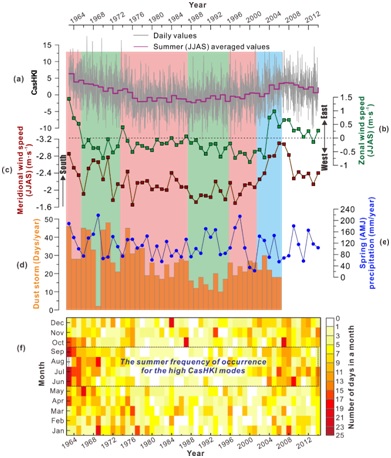Loess deposits constitute one of the most valuable paleoenvironmental archives over Central Asia. However, the gap of knowledge of the physical loess-climate (sub)system linkages hampers paleoclimatic reconstruction with the loess-paleosol sequences, especially for those in southern Central Asia where loess formed extensive landforms, and the oldest and thickest loess stratigraphy in Central Asia by far were preserved.
Recently, the Research Group for Central Asian loess lead by Prof. SONG Yougui from the Belt&Road Center for Climate and Environment Studies (B&RCCES), Institute of Earth Environment, Chinese Academy of Sciences, with their colleagues clarify the potential links between the atmospheric circulation patterns, aeolian dust transport and deposition and formation of loess sediments in Tajikistan.
They compared stable trace elements in the loess sediments of the Ili Basin in northwest China, the Fergana Valley in Kyrgyzstan, and Tajikistan to uncover a strong likelihood of local sourcing and lesser contribution from the great deserts in Central Asia for the Tajikistan loess, despite a very close distance from the great Central Asian deserts.
Subsequently, they investigated atmospheric processes in Tajikistan under the guidance of the geochemical results. It was illustrated that variability in dust activity over the region was a function of several parameters related to precipitation, soil moisture, vegetation cover, and the local/regional wind, with dust emission maximizing during the hot and dry summer season.
Profound and detailed study of atmospheric circulation patterns produced a clearer picture of dust activity in Tajikistan. The researchers provided a first evidence for an important role of the Caspian Sea - Hindu Kush Index (CasHKI) in controlling the long-term aeolian processes in Tajikistan while precipitation affects most likely the interannual timescales.
This study, published in Atmospheric Research, narrows the gap between Tajikistan loess accumulation and atmospheric dynamics, and has implications in terms of interpretation of palaeoclimatic proxies of loess-paleosol sequences in southern Central Asia.

Daily and summer-mean (June-September) CasHKI values (1963 – 2014) (a), inter-annual variation of the NCEP/NCAR meridional (b) and zonal (c) wind speed (1963 – 2014) and the dust storms (days per year) (d) at Termez station (37.3°N, 67.3°E) in southeastern Uzbekistan, spring (April, May, June) total precipitation (mm) over the Afghan-Tajik Basin (36.7° –38.6°N, 67.3° – 70°E) (NCEP/NCAR, 1963 – 2014) (e), temporal variation of the frequency of occurrence for the high CasHKI modes on monthly scale (f). (Imaged by LI Yue, et al.)
Contact: Bai Jie, Institute of Earth Environment, Chinese Academy of Sciences, Xi'an, China. Email: baijie@ieecas.cn
 © 2015 Institute of Earth Environment,CAS
© 2015 Institute of Earth Environment,CAS Address:No. 97 Yanxiang Road, Xi'an 710061, Shaanxi, China

 Location :
Location :